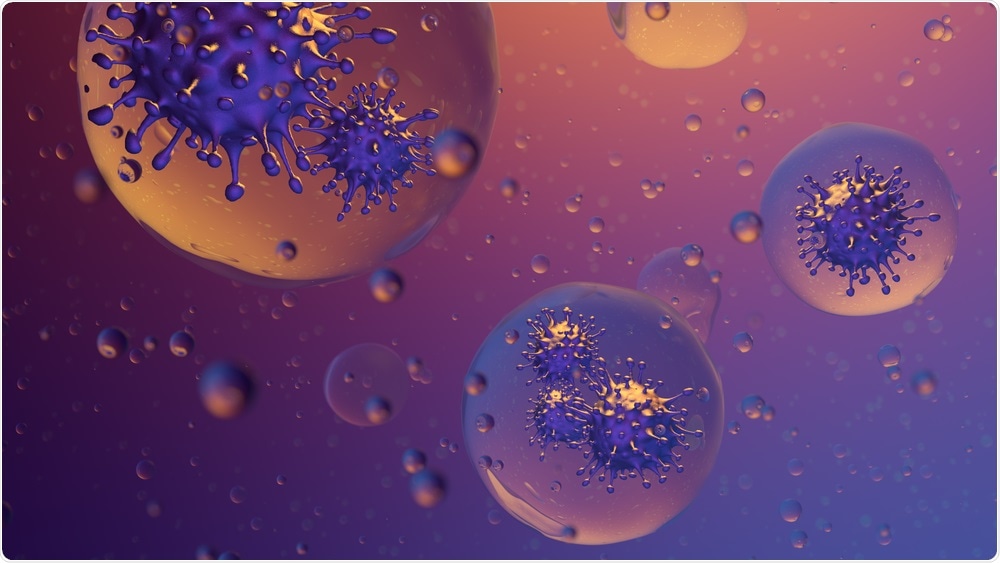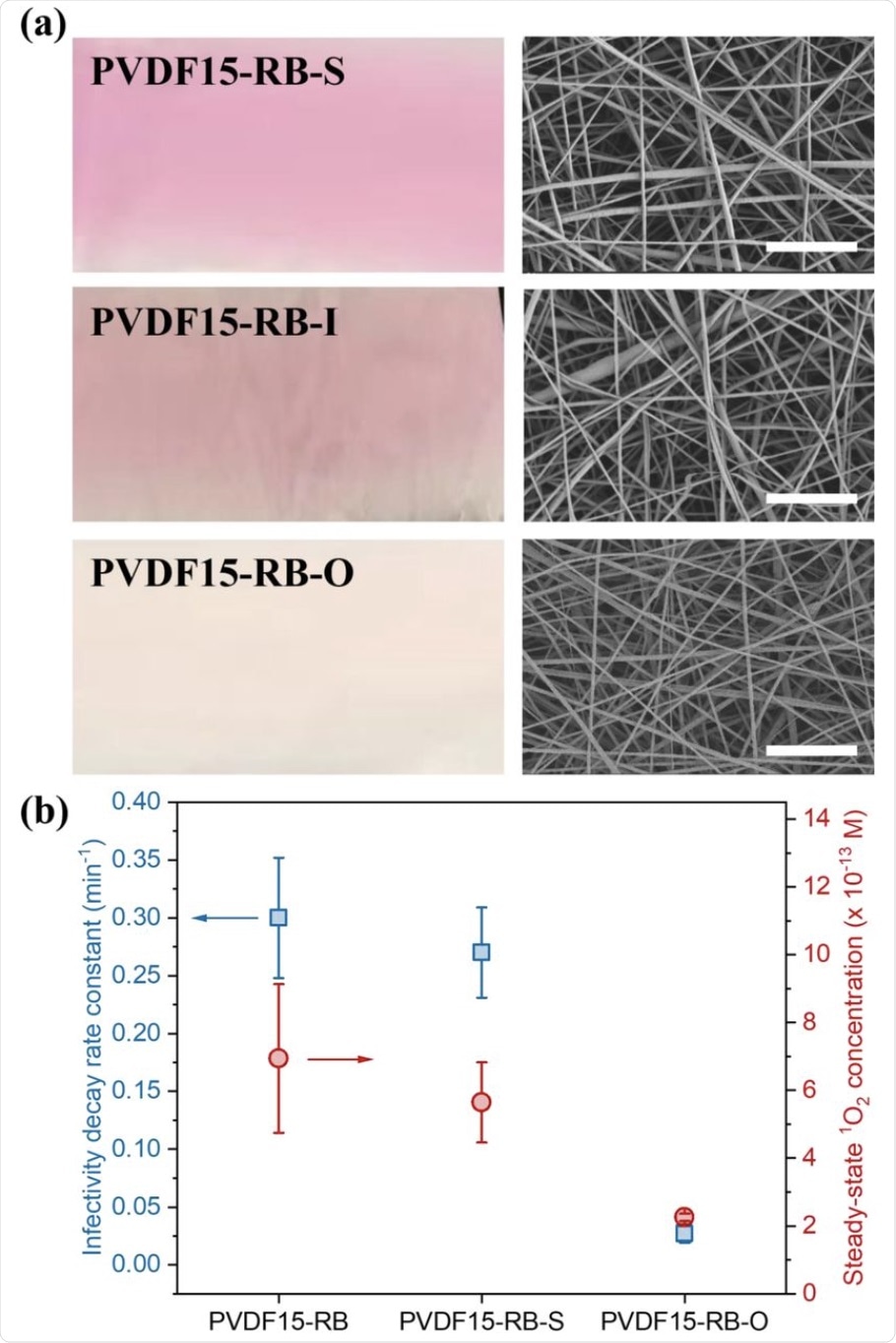The World Health Organization (WHO) and the United States Centers for Disease Control and Prevention (CDC) have recognized airborne transmission of the severe acute respiratory syndrome coronavirus 2 (SARS-CoV-2). SARS-CoV-2 is a highly infectious ribonucleic acid (RNA) virus that was first reported in Wuhan, China in December 2019. Owing to the rapid outbreak of SARS-CoV-2 across the globe, the WHO announced the coronavirus disease 2019 (COVID-19) to be a pandemic in March 2020.
Scientists have claimed that SARS-CoV-2 aerosols could remain active in the air for up to several hours. People are therefore encouraged to use physical barriers such as face masks and face shields to reduce the transmission of SARS-CoV-2 through aerosols. This policy has been substantiated by several peer-reviewed studies confirming that the use of face masks significantly reduces the transmission of SARS-CoV-2.
 Study: Photosensitized Electrospun Nanofibrous Filters for Capturing and Killing Airborne Coronaviruses under Visible Light Irradiation. Image Credit: CROCOTHERY / Shutterstock.com
Study: Photosensitized Electrospun Nanofibrous Filters for Capturing and Killing Airborne Coronaviruses under Visible Light Irradiation. Image Credit: CROCOTHERY / Shutterstock.com

 This news article was a review of a preliminary scientific report that had not undergone peer-review at the time of publication. Since its initial publication, the scientific report has now been peer reviewed and accepted for publication in a Scientific Journal. Links to the preliminary and peer-reviewed reports are available in the Sources section at the bottom of this article. View Sources
This news article was a review of a preliminary scientific report that had not undergone peer-review at the time of publication. Since its initial publication, the scientific report has now been peer reviewed and accepted for publication in a Scientific Journal. Links to the preliminary and peer-reviewed reports are available in the Sources section at the bottom of this article. View Sources
Electrospun membranes
One of the most promising fiber production techniques is electrospinning. This technique has been used to develop non-woven, ultrafine fibrous membranes that have the ability of filtering out aerosols.
The pore size of the electrospun membranes ranges from tens of nanometers (nm) to several micrometers (µm). The increased surface area and porosity of these membranes create an excellent material for the development of superior aerosol filters. These electrospun membranes can further improve aerosol filtration via electrostatic attraction.
A previous study has shown that electrospun membranes could trap up to 99.9% of coronavirus aerosols, whose size was comparable to most penetrating particles in mechanical air filtration. To date, the air filters based on electrospun membranes, which are currently available in the market, can efficiently capture virus aerosols but cannot inactivate them. This may lead to secondary contamination.
Photosensitized electrospun nanofibrous membranes
A new study published on the preprint server bioRxiv* discusses the development of highly efficient photosensitized electrospun nanofibrous membranes that are capable of capturing and inactivating coronavirus aerosols. The current study also reveals the mechanism of photooxidation and inactivation of coronaviruses at a molecular level.
Herein, the researchers used dye photosensitizers as antimicrobial additives for electrospinning. The photosensitizers get excited upon exposure to visible light and subsequently produce highly reactive singlet oxygen that can effectively kill viruses. Two of the main advantages associated with this technique are that it is a cost-effective and safe approach for the removal of virus aerosols.
Some dye photosensitizers such as Rose Bengal (RB) have received approval from the U.S. Food and Drug Administration (FDA) for biomedical applications. Previous research has shown RB to be the most photoreactive dye additive for membrane fabrication with virucidal activity.
The authors of this study also demonstrated self-cleaning features in the newly developed photoreactive electrospun filter under ambient conditions. This filter can be used in wind-ranging air filtration applications such as respirators, face masks, and indoor filters.
For the most efficient activity, the researchers optimized the composition of the photoreactive electrospun nanofibrous membranes so that they could offer superior sodium chloride (NaCl) filtration. The membranes were also designed to allow for the highest production of reactive singlet oxygen when in the presence of visible light irradiation.
 (a) Photos and SEM images of PVDF15-RB membranes after aging. Scale bars in the SEM images are 5 µm; (b) first-order decay rate constants of MHV-A59 infectivity in droplets and the corresponding 1O2 production on fresh and aged PVDF15-RB membranes. All tests of virus inactivation and 1O2 production were conducted under the irradiation of simulated reading light. Error bars for the infectivity decay rate constant represent the standard error of the negative slope of the linear regression of common logarithm of infectivity versus light exposure duration, and error bars for the steady-state 1O2 concentration represent the standard deviation of triplicate measurements.
(a) Photos and SEM images of PVDF15-RB membranes after aging. Scale bars in the SEM images are 5 µm; (b) first-order decay rate constants of MHV-A59 infectivity in droplets and the corresponding 1O2 production on fresh and aged PVDF15-RB membranes. All tests of virus inactivation and 1O2 production were conducted under the irradiation of simulated reading light. Error bars for the infectivity decay rate constant represent the standard error of the negative slope of the linear regression of common logarithm of infectivity versus light exposure duration, and error bars for the steady-state 1O2 concentration represent the standard deviation of triplicate measurements.
Evaluating the antiviral efficacy
Hydrophilic photosensitizers were also incorporated into the hydrophobic polyvinylidene difluoride (PVDF) in an effort to protect the photosensitizer from leaching. The presence of RB in the filter rapidly inactivated about 98.9% of the murine hepatitis virus aerosols (MHV26 A59) within fifteen minutes of irradiation with reading light. MHV26 A59 is regarded as a coronavirus surrogate for SARS-CoV-2.
When the filter was immersed in water for six hours, minimal RB release was recorded, thereby suggesting that moisture from human breath or ambient air will not have a significant effect on photosensitizer leaching. Therefore, this photoreactive nanofibrous membrane could be used in both face masks as well as indoor air filters.
The researchers emphasized the importance of analyzing the pressure drop in the filtration to understand the breathability or energy consumption in filtration. Typically, the diameter of nanofibers surges with an increase in the PVDF concentration.
In this study, the fiber diameter of the newly developed ultrafine membrane was reported to be 200 nm, with a small pore size of about 1.5 µm. The authors revealed that the optimized nanofibrous membrane could filter out around 99.2% MHV26 A59.
The robustness of this membrane was also evaluated. To this end, the effectiveness of these membranes in filtering MHV32 A59 aerosols did not decrease when they were exposed to indoor light for a prolonged period. However, when the membranes were subjected to sunlight for several days, they were photobleached, which decreased the production of singlet oxygen. As a result, the performance of the electrospun nanofibrous membrane in disinfecting MHV-A59 in droplets was compromised.
Future studies
The deactivation of coronaviruses by the membrane discussed here appears to occur through the production of singlet reactive oxygen that could disrupt the virus genome and, thereby, inhibit virus binding to host cells.
Future work on these membranes will include the development of robust photoreactive air filters with an extended lifespan. The authors of this study anticipate that future work will also overcome the problem of photobleaching the dye-sensitized membranes.

 This news article was a review of a preliminary scientific report that had not undergone peer-review at the time of publication. Since its initial publication, the scientific report has now been peer reviewed and accepted for publication in a Scientific Journal. Links to the preliminary and peer-reviewed reports are available in the Sources section at the bottom of this article. View Sources
This news article was a review of a preliminary scientific report that had not undergone peer-review at the time of publication. Since its initial publication, the scientific report has now been peer reviewed and accepted for publication in a Scientific Journal. Links to the preliminary and peer-reviewed reports are available in the Sources section at the bottom of this article. View Sources
Journal references:
- Preliminary scientific report.
Shen, H., Zhou, Z., Wang, H., et al. (2021). Photosensitized Electrospun Nanofibrous Filters for Capturing and Killing Airborne Coronaviruses under Visible Light Irradiation. bioRxiv. doi:10.1101/2021.07.29.454404. https://www.biorxiv.org/content/10.1101/2021.07.29.454404v1.
- Peer reviewed and published scientific report.
Shen, Hongchen, Zhe Zhou, Haihuan Wang, Jiahao Chen, Mengyang Zhang, Minghao Han, Yun Shen, and Danmeng Shuai. 2022. “Photosensitized Electrospun Nanofibrous Filters for Capturing and Killing Airborne Coronaviruses under Visible Light Irradiation.” Environmental Science & Technology 56 (7): 4295–4304. https://doi.org/10.1021/acs.est.2c00885. https://pubs.acs.org/doi/10.1021/acs.est.2c00885.